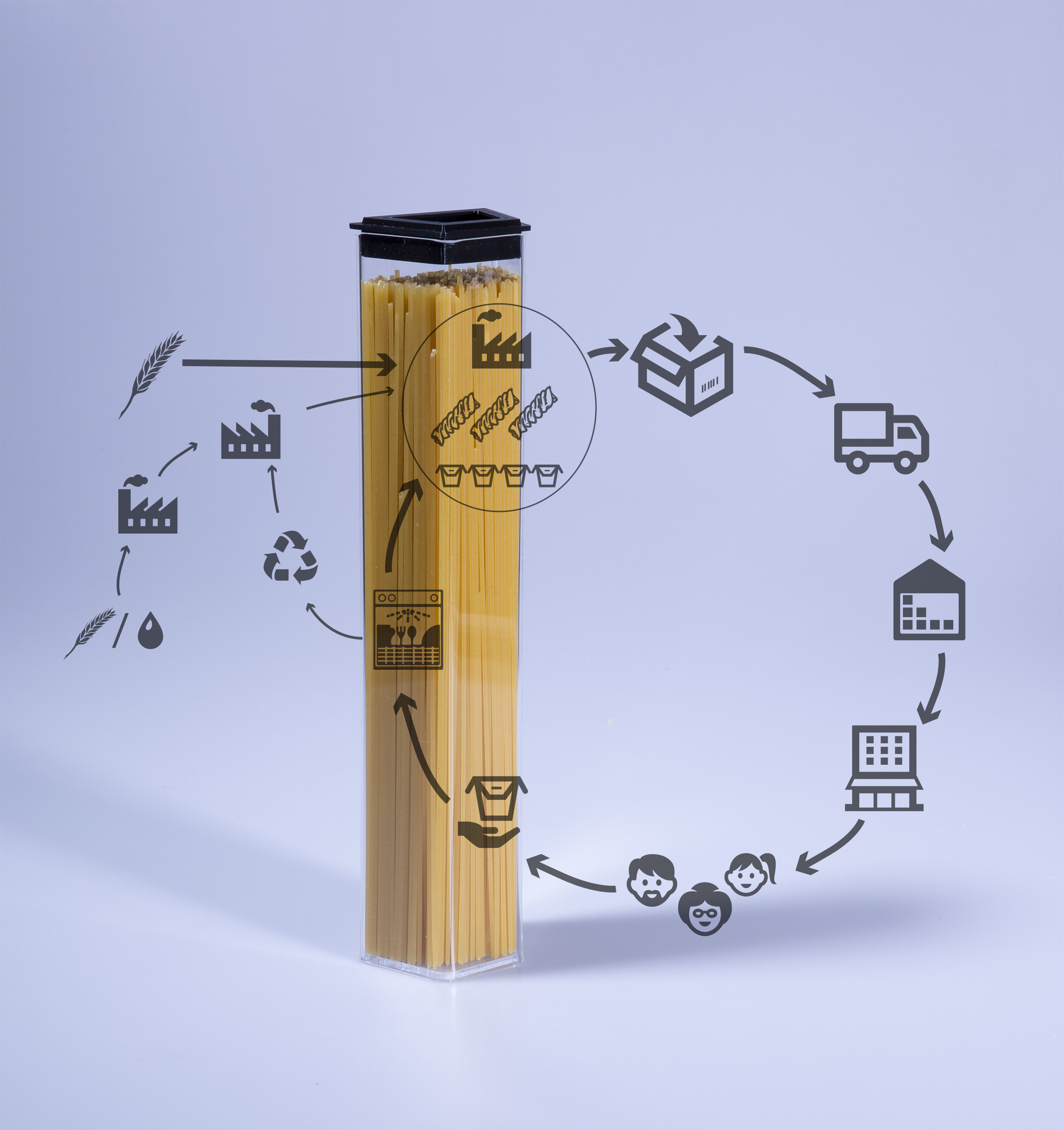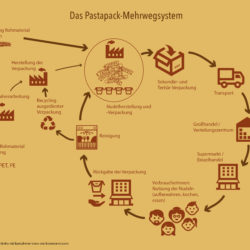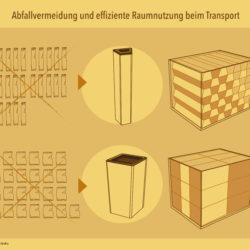Pastapack
Description
Pastapack is a concept which examines a system of returnable, reusable packaging for the food retail sector, using pasta as an example product. One Pasta-Box saves up to 25 pieces of disposable packaging and thus helps to reduce packaging waste. The concept is based on the returnable system for deposit bottles: Empty Pasta-Boxes are returned, cleaned and refilled. The use of Pastapack is made easier for retailers by using the same structures (including existing return machines) to collect the packaging. Previous project results also include graphic suggestions for label design and a sketch of the business model for ongoing operations.What is the Topic?
The topic of the project is the reduction and avoidance of waste. Reusable systems are examined as a possible approach and a connection is made to the requirements for environmentally and user-friendly system and packaging design. The overall concept is in the foreground: effects of the system on transport emissions and demands on cleaning and filling systems of pasta manufacturers are taken into account as well as the needs of end users. Packaging waste and the associated environmental pollution are an urgent problem of our time. Many people do not feel as responsible as to change their shopping habits drastically. Pastapack addresses these customers by its positioning in the supermarket. The reusable packaging can be used without having to visit additional stores or bring enough of your own containers for each purchase.
Why does it look like this?
The presentation of the reusable system explains the packaging cycle clearly and understandably. Therefore, royalty-free icons from iconmonstr.com are used. The development of new icons will be sought in the future in order to give the explanatory presentations of Pastapack a character that fits the desired effect of the project communication to the outside. However, as part of the thesis, the creation of new icons would have gone beyond the time frame. In my interviews with potential users, it was shown that most would like the packaging to be at least partially transparent. Accordingly, a transparent material was chosen for the pasta boxes. A basis for the form finding was the ability for optimal layering in standard transport boxes. This makes transportation more efficient both from an ecological and an economic perspective. Other points taken into consideration are the manageability of the packaging, safe storage options (e.g. the pasta boxes have large contact surfaces so that they cannot roll off the shelf) and dimensions that allow return through the opening of the empties return machine. Different shapes were tested, whereby the trapeze prism proved not only to be a spaghetti packaging with a new, unique character, but also to be the most efficient variant. The fusilli box requires a different shape with a larger volume for the pasta it contains. Cuboids were the most practical variants here. Two sides are chamfered and give the container the appearance of a modern snack box rather than a can, as is already known from numerous other foods. The flexible lids sit securely on the packaging, but are also easy to open. No tools (scissors, knives, can openers, etc.) are required. A variant of the lid for the Fusilli box improves the stackability of the containers. Because retail packaging cannot do without product graphics, I also designed exemplary labels. Potential customers can imagine using the pasta boxes more easily when they are equipped with labels. The graphic indicates the novelty of the product packaging by means of markings highlighted in red which generats attention. A large illustration with a short, explanatory text ensures that customers know that they can return the packaging in the empties return machine and receive a deposit for it. This is important because deposit packaging outside of the beverage sector is an innovation. Strips of the label running across the lid act as a seal which indicates that the packaging has not yet been opened. Plus, they can also be used as a handle on the Fusilli box.
What is special?
Compared to common packaging options such as single-use plastic or paper bags and cardboard boxes, Pastapack is characterized by the fact that it saves waste. Here only the labels arise, the material requirements of which are deliberately kept low. In the further development of the project, they will be replaced by a waste-free alternative if possible. Compared to packaging-free departments, Pastapack requires fewer changes in purchasing behavior and thus makes environmentally friendly shopping easier. In this way, greater efficiency can be achieved because more end customers are motivated to use Pastapack. Pastapack is the only reusable concept for pasta packaging and can be expanded to include packaging for other foods, too. Findings from the analysis of the advantages and disadvantages of other packaging types flow into the development as well as the observation of current improvement approaches in the packaging sector. The concept can also be extended to other shopping situations. For example, containers for self-filling can be added for shopping at zero-waste shops.
What is new?
The use of reusable containers for food outside of the beverage and milk product sector is new. In addition, new boxes are made of recyclates to the highest possible share. This practice is not yet widespread because recyclates have so far been relatively expensive and the hygiene of food packaging has to be guaranteed. The Pastapack project wants to play a pioneering role here, because the more recycled materials are in demand and used, the faster their processing will continue to develop. Unfortunately, it is still not a matter of course today that food packaging can be 100% recycled in ordinary recycling plants. It often consists of several different plastics melted together that cannot be easily separated. This reduces the type purity that is crucial for successful recycling. In contrast, Pastapack is made of pure PET, like the easily recyclable deposit bottles that are already widely used. The lids are also made from a single plastic, so that after the maximum number of passes through the reusable system, complete recycling is guaranteed. A pasta pack made of glass is also conceivable, but due to its higher weight, it only makes sense to use it with short transport routes from the noodle production to the point of sale. The shapes of the containers are also new, especially those of the spaghetti box. They stand out from numerous frequently occurring packaging variants from the supermarket shelf, for example from flexible bag shapes, rectangular boxes and round, square or hexagonal glasses and bottles.




